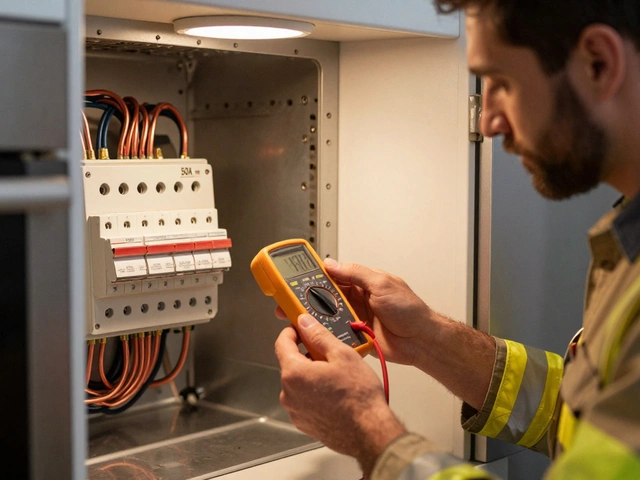If your fan just died in the middle of a blistering July afternoon, you’re probably sweating buckets and cursing your luck. But before you lug the fan to the curb or call an expensive repair service, know this: a dead fan isn’t always dead for good. Most “broken” fans can be coaxed back to life with a little patience and some do-it-yourself hustle. Ever wonder why appliances always fail at the worst possible moment? Blame it on dust, loose wires, or good old-fashioned mechanical wear. The truth is, fans are stubborn, simple machines, and when they quit, it’s often because of a problem that’s hiding in plain sight. Ready to bring that dead fan back to life?
Understanding How Fans Work: The Basics Matter
Fans look straightforward, but there’s a bit more going on under the hood than spinning blades. All fans—desk, pedestal, floor, or window—work with just a few key parts: an electric motor, a spindle or shaft, blades, a speed controller (usually a knob or a button), and a power cord. When you flip the switch, electricity flows into the motor, which turns the spindle and makes the blades whoosh. Simple, right? Actually, each piece is a potential troublemaker. The tiniest bit of grime on a bearing, a kink in the wire, or a speck of rust can grind things to a halt. Did you know that most household fans rely on an AC induction motor—the same basic technology invented over a century ago? They’re stubborn old workhorses. No digital bells or whistles, no smart features. That means they're also pretty fixable.
When the fan stops cold, it’s because either something electrical is interrupting the power, or something mechanical is jamming the spin. Electrical failures can be sneaky, hiding inside the plug, switch, cord, or even inside the motor windings. Mechanical failures are a little easier to spot: a wobbly blade, a stuck shaft, a base clogged with dust or pet hair. Sometimes it’s both. In a 2019 repair survey, nearly 70% of non-working fans revived with just a deep clean and a power cord check. That means most folks toss a perfectly fixable fan because they don’t realize what’s going on. So before you toss yours, let’s break down exactly what can go wrong.
First Steps: Before You Break Out the Tools
First things first: unplug that fan. Safety is king—nobody wants a shock, and you don’t need power to do the basics. Now, resist the urge to start unscrewing everything. The simplest fixes don’t require any tools at all. Here’s what you should check right away:
- Confirm the outlet has power. Plug something else in—like a lamp or your phone charger. If the outlet is dead, try a different one or check your breaker panel. You’d be surprised how many "fan repairs" are just wall socket issues.
- Examine the power cord. Look for splits, fraying, or burn marks. A bad cord is a top culprit, especially if you've been yanking it to unplug.
- Try the fan’s switch or speed buttons. If it feels loose or doesn’t click, you might have an internal switch problem.
- Look for signs of overheating. If the base smells burnt, or you see soot, let the fan cool off and don’t use it until you inspect the inside. Some old fans even have a thermal fuse hidden near the motor that pops if things get too hot.
- Check for physical blockages: Are the blades jammed? Pet hair, dust bunnies, or a kid’s Lego can wedge in there.
Now, here’s a fun stat: according to a Home Appliance Survey from 2022, 38% of broken fans were fixed with just a cord replacement or a fuse reset. So take those first simple checks seriously. Sometimes the obvious stuff is all it takes.
Getting Your Hands Dirty: Deep Diagnosis and Easy Fixes
If you’ve done the easy stuff and the fan’s still a lump of plastic and metal, it’s time to open it up. Don’t worry—it’s usually just a couple of screws at the grille or base. Here’s your battle plan:
- Clean it out. Dust plus humidity is the enemy of fan motors. Use a vacuum or compressed air to blast dust away from the grills, blades, and especially the motor housing. Sticky buildup can slow blades or overheat the motor.
- Look at the wiring. Most fans only have a couple connectors between the cord, switch, and motor. Any loose or burnt wire? Blackened connectors or obvious cracks? If so, reattach or replace as needed. You can usually get basic **fan repair** kits online or at hardware stores.
- Spin the blades by hand. Feel resistance or grinding? That’s a telltale sign of a dried-out or gummed-up bearing. Try adding a couple drops of light machine oil (never WD-40—it evaporates too fast) to the shaft. Spin again. Is it smooth now?
- Switch and speed control. Use a multimeter to check continuity across the switch terminals. If it’s dead on all settings, you’ll need a replacement. Switches are cheap and fit into most generic desk or pedestal fans.
- Thermal fuse. Some fans have a built-in little fuse soldered inside the motor or under a small cover. If that’s blown, the fan won’t run until you install a new one. Look for a tiny white or silver cylinder marking near 115°C-130°C. These cost about $2 at an electronics shop.
Mechanical issues top the list of simple fixes. If the blades are bent, gently straighten them. A little wobble is common, but a big wobble can stress the motor and send the fan crashing off the table. If your fan uses a belt and the belt’s snapped or loose, get a replacement (use the model number or bring the old belt to the shop—it’s the easiest way to match size). According to appliance parts supplier stats, replacing a $5 fuse or a $10 belt is the number one reason fans come back from the dead.

Advanced Troubleshooting: Digging Deeper for Stubborn Issues
If you’ve checked the basics and tried the usual fixes yet nothing’s happening, your fan probably has a deeper electrical issue or mechanical failure. Here’s how you can keep going—but only if you’re comfortable and have basic tools. And as always, safety first: unplug before doing anything.
- Motor windings. Burnt smell, visible discoloration, or zero movement even after checking fuses? Test the coil resistance with a multimeter. It should measure under 100 ohms for most home fans (check your model specs). An open circuit or infinite resistance? The motor’s cooked. Time to weigh repair vs. replacement costs.
- Capacitor problems. Many pedestal or standing fans have a run capacitor (a small canister, usually white or silver, wired to the motor). If you hear humming but no spin, give the blades a gentle push. If it starts running, your capacitor’s on its last legs. Swap it for an identical one. Capacitors typically cost under $10.
- Check connections and solder joints on the circuit board (if your fan has one). Loose, broken, or corroded joints are a common cause of “mystery” failures. A dab of solder sorts this fast if you know how.
- Fan speed controller. Rarely, the speed control board itself fails—usually visible as burnt areas or bulging capacitors. Compare prices for parts; sometimes it’s cheaper to grab a universal replacement module online.
- Fan blade balance. If you’ve got vibration, remove and remount the blades. Never run a fan with major wobble—it stresses the bearings and can quickly ruin the motor.
Wonder about the average lifespan of a household fan? Most survive 5-8 years with regular cleaning. But with annual oiling and dust removal, you’ll easily double that. Here’s a quick reference table with common fan problems and solutions:
| Problem | Likely Cause | Fix |
|---|---|---|
| Fan won’t turn on | No power, loose cord, bad switch or fuse | Test outlet, replace cord, check switch or fuse |
| Fan hums but doesn’t spin | Bad capacitor, stuck motor, dirty bearing | Replace capacitor, oil bearing, clear debris |
| Fan runs slow/wobbles | Unbalanced or bent blade, weak capacitor | Straighten blade, replace capacitor |
| Fan smells burnt | Overheating motor, blocked vent, electrical short | Clean motor, check thermal fuse, inspect wiring |
Smart Maintenance: Keeping Your Fan Running Year-Round
Even if you got your fan spinning smoothly again, don’t just set it and forget it. Fans love a little attention. Give the blades and grills a wipe-down every couple of weeks. If you have pets, clean out loose fur monthly—it’s amazing how much hair collects inside the base of a standing fan. Every spring (or at least once a year), do a full deep-clean: take apart the casing, dust off the motor and shaft, and add a tiny drop of sewing machine oil where the shaft goes into the motor. Lubrication keeps things spinning quietly—no ear-splitting squeaks during your nap.
Store your fan indoors when not in use. Humidity and temperature swings in garages or sheds encourage rust, which spells doom for any motor. And never wrap the cord tightly around the base—it stresses the wires inside, causes kinks, and eventually leads to shorts. Remember, the biggest fan-killers are dust, moisture, overheating, and rough handling. Want a tip that’s so simple most people skip it? Keep the manual! Service instructions and part numbers make replacement repairs way easier—and you can often find digital copies online if you've tossed the original.
Finally, stop running your fan 24/7. Most domestic models aren’t built for constant use. Give your fan a break every few hours—modern fans are more efficient, but the motors still generate heat, and overheating shortens their life. In a study from the Appliance Service Institute, fans used in 4-hour sessions lasted on average 2 years longer than those left running all day.
When to Call It Quits: Repair vs. Replacement
So, after everything, your fan might still be stubbornly silent. If you’ve replaced the fuse, checked the wiring, oiled the shaft, swapped the capacitor, and it’s still dead, you’ve probably reached the “call it” stage. Repairing the motor windings or replacing the entire motor starts to rival the price of a new quality fan. If your fan is over 10 years old, uses a lot of power, or makes a constant burnt smell, it’s likely safer and more economical to recycle it and grab a new one.
If your fan has unusual features—like a vintage oscillating model or a “smart” digital fan—parts might be worth hunting down, especially if there’s sentimental or practical value. Specialty appliance repair shops sometimes have rare motor or controller parts, but balance that against the cost of just buying a new fan. Keep an eye out for energy efficiency stars and auto-off timers in modern units—they’ll cost less to run and help avoid overheating in the future.
One last thought: before you recycle a dead fan, strip off usable bits. Power cords, switches, and screws come in handy for other repair jobs. Call your local e-waste center for safe disposal—motors contain copper, and sometimes fans use small amounts of hazardous materials. No need to let the planet suffer just because your living room got stuffy.
So next time your fan goes kaput on a boiling hot day, don’t panic. Most fixes are fast, cheap, and completely within reach. Sometimes a couple bucks, some simple tools, and a bit of patience are all you need to bring the breeze back home.



